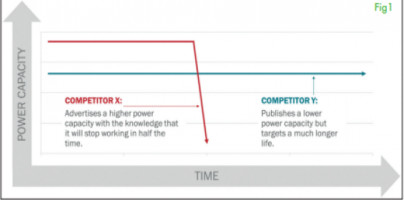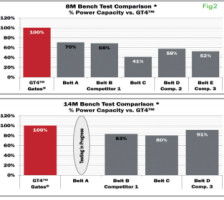Comprehensive belt ratings: a new level of predictive accuracy
Published: 17 January, 2022
With the launch of Gates’ GT4, the company highlights how it has conducted the most comprehensive ratings development plan in its history in order to provide its customers with the most accurate predictive tools in the industry. PWE reports.
Combined with Gates’ deep technical knowledge and the latest developments in the fields of elastomeric composite failure mechanics, statistics, and test development, the company told PWE that the launch of Gates’ GT4 has brought a new level of predictive accuracy.
For some manufacturers, belt ratings are a marketing tool to help with the purchasing process, but Gates explains they are a science. This is why it went through the costly and timeconsuming process of developing its belt ratings for GT4 from scratch rather than just multiplying old ratings by a fixed percentage or copying the HP tables from a competitor.
Anytime a change is made to an existing predictive model there will be areas where the old model and the new model differ. This, says Gates, isn’t to say that the old model was bad or wrong just that it is less accurate than the new one.
With this in mind there will be some drive designs where its predictive model for GT4 will provide a HP rating below that of the previous GT3 generation. This does not mean that GT4 is less capable than GT3. In fact, the opposite is true explains Gates. GT4 has been proven to be superior to GT3 at all conditions throughout its testing process. A more accurate method of predicting and modelling the belts performance results in a higher level of confidence in the GT4 product. Again, if you’ve had a drive in the past that used GT3 without any issues then Gates emphasises that you can feel confident that GT4 will also prove successful as all of its test data shows GT4 to consistently outperform GT3 in every drive configuration.
Truth in testing: Power capacity vs. actual performance
Power ratings are the traditional method used by belt manufacturers to communicate the capability of their belts in varying conditions. Using known information 'RPM, sprocket diameters and belt length' a drive designer can use power rating tables and manufacturerspecified calculations to determine the required belt width to properly transfer power necessary for their application. However, there are no factors included in this process to determine the lifetime expectancy the manufacturer expects for a given rating.

No standards
The power transmission industry has no standards in place for manufacturers to follow when developing power rating tables. This has resulted in a wide range of unstandardised methods used by manufacturers over time. With no industry regulations or standardisations in place, there is no guarantee that manufacturer-driven power ating results are factual, or data based. For example, a very lightweight belt is rated to carry 100HP, despite it not being capable of doing so for any meaningful length of time. Given the inconsistencies described above, the comparison of multiple power rating tables (including any power rating software outputs used) are unreliable and should not be used to determine relative performance across competitive belt lines. The only way to know the true power carrying capacity is to test various belts under identical conditions and determine their ability to carry a given load for a certain amount of time.
Gates brought in many of the primary competitors within the same class for ‘apples-toapples’ testing.
https://www.linkedin.com/company/gates-corporation/






 JBC says there are exciting times ahead with its new product launch. The company says ‘HALO’ uses cutting edge technology to create a remote boilerhouse monitoring system, using analogue, digital and mod bus outputs, providing a critical overview into asset performance and fuel, water, steam and power are monitored in real time, delivering consumption and cost per Kg of steam raised.
JBC says there are exciting times ahead with its new product launch. The company says ‘HALO’ uses cutting edge technology to create a remote boilerhouse monitoring system, using analogue, digital and mod bus outputs, providing a critical overview into asset performance and fuel, water, steam and power are monitored in real time, delivering consumption and cost per Kg of steam raised.
